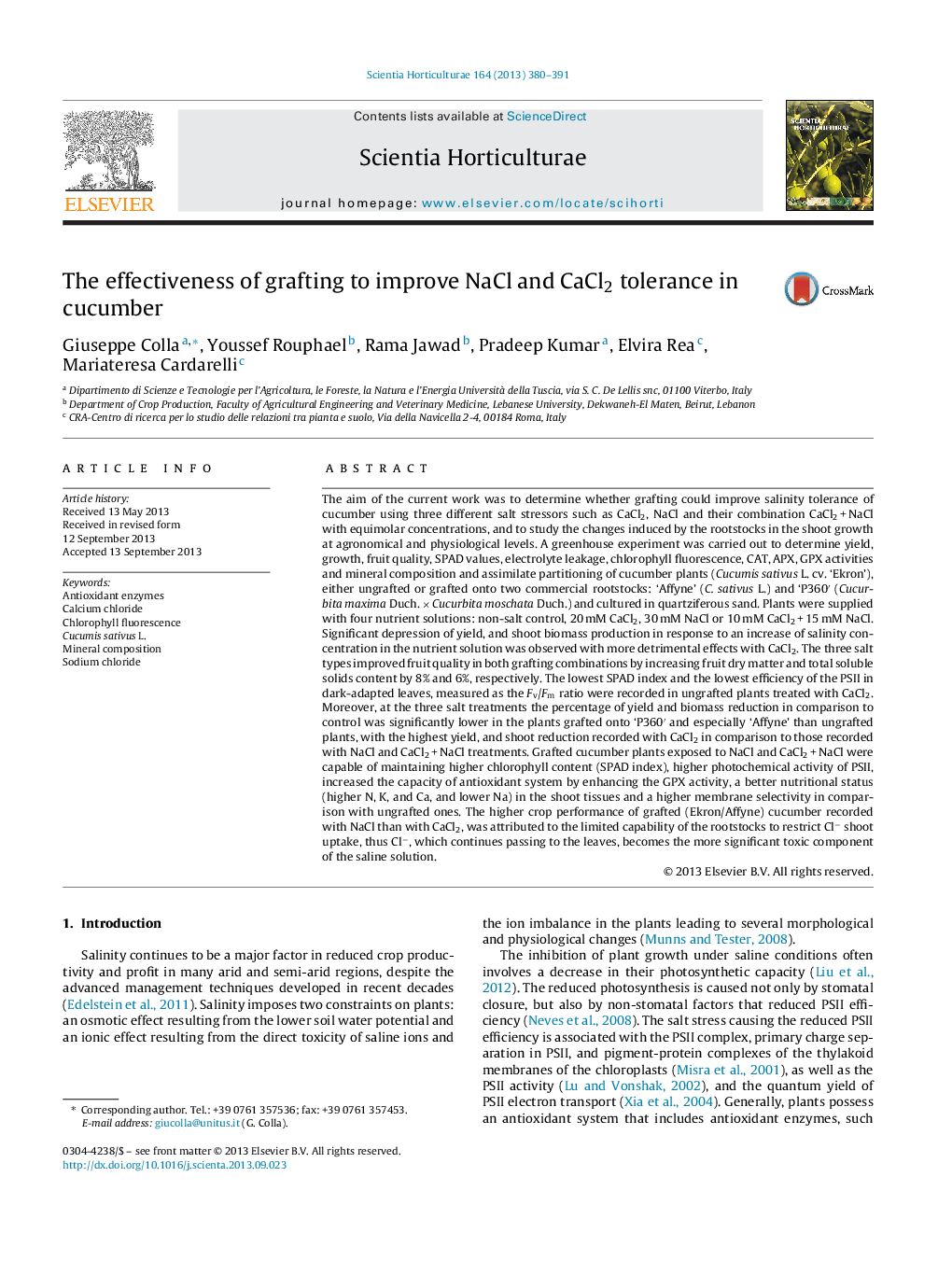| کد مقاله | کد نشریه | سال انتشار | مقاله انگلیسی | نسخه تمام متن |
|---|---|---|---|---|
| 4567084 | 1628834 | 2013 | 12 صفحه PDF | دانلود رایگان |

• Salinity tolerance of grafted and ungrafted cucumber plants was evaluated.
• Growth and yield decreased in response to salinity especially in CaCl2 treatment.
• Grafting improved tolerance to salinity reducing Na and Cl accumulation in shoots.
The aim of the current work was to determine whether grafting could improve salinity tolerance of cucumber using three different salt stressors such as CaCl2, NaCl and their combination CaCl2 + NaCl with equimolar concentrations, and to study the changes induced by the rootstocks in the shoot growth at agronomical and physiological levels. A greenhouse experiment was carried out to determine yield, growth, fruit quality, SPAD values, electrolyte leakage, chlorophyll fluorescence, CAT, APX, GPX activities and mineral composition and assimilate partitioning of cucumber plants (Cucumis sativus L. cv. ‘Ekron’), either ungrafted or grafted onto two commercial rootstocks: ‘Affyne’ (C. sativus L.) and ‘P360′ (Cucurbita maxima Duch. × Cucurbita moschata Duch.) and cultured in quartziferous sand. Plants were supplied with four nutrient solutions: non-salt control, 20 mM CaCl2, 30 mM NaCl or 10 mM CaCl2 + 15 mM NaCl. Significant depression of yield, and shoot biomass production in response to an increase of salinity concentration in the nutrient solution was observed with more detrimental effects with CaCl2. The three salt types improved fruit quality in both grafting combinations by increasing fruit dry matter and total soluble solids content by 8% and 6%, respectively. The lowest SPAD index and the lowest efficiency of the PSII in dark-adapted leaves, measured as the Fv/Fm ratio were recorded in ungrafted plants treated with CaCl2. Moreover, at the three salt treatments the percentage of yield and biomass reduction in comparison to control was significantly lower in the plants grafted onto ‘P360′ and especially ‘Affyne’ than ungrafted plants, with the highest yield, and shoot reduction recorded with CaCl2 in comparison to those recorded with NaCl and CaCl2 + NaCl treatments. Grafted cucumber plants exposed to NaCl and CaCl2 + NaCl were capable of maintaining higher chlorophyll content (SPAD index), higher photochemical activity of PSII, increased the capacity of antioxidant system by enhancing the GPX activity, a better nutritional status (higher N, K, and Ca, and lower Na) in the shoot tissues and a higher membrane selectivity in comparison with ungrafted ones. The higher crop performance of grafted (Ekron/Affyne) cucumber recorded with NaCl than with CaCl2, was attributed to the limited capability of the rootstocks to restrict Cl− shoot uptake, thus Cl−, which continues passing to the leaves, becomes the more significant toxic component of the saline solution.
Journal: Scientia Horticulturae - Volume 164, 17 December 2013, Pages 380–391